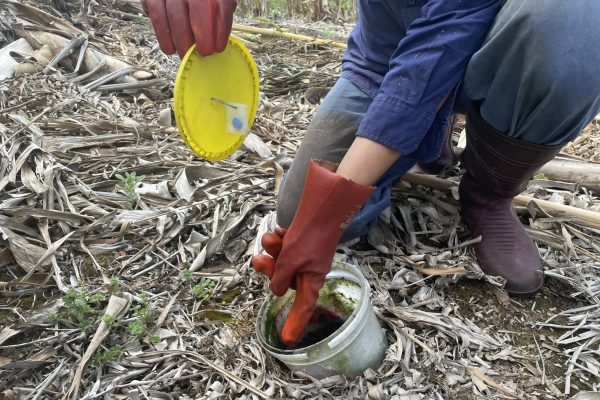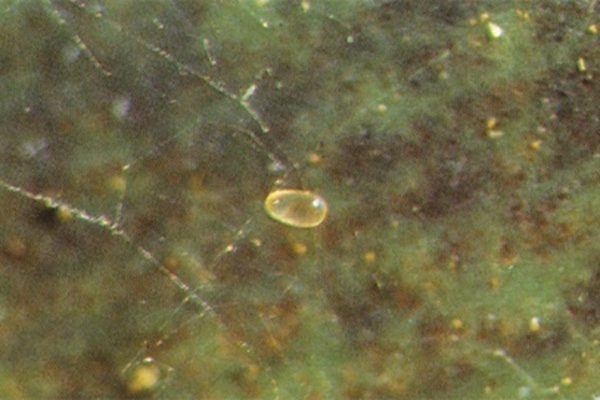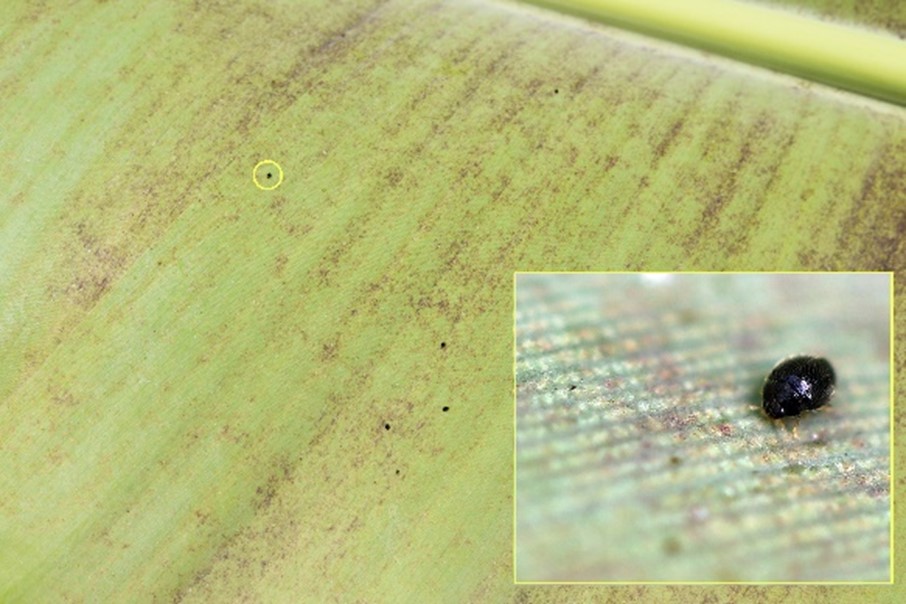Banana scab moth – Nacoleia octasema
Monitoring and control options
Monitoring
Being proactive and regularly checking bunches or getting feedback from baggers can help growers discover infestations before the fruit reaches the packing shed. Although damage can’t be undone, identifying, and addressing problems (retraining or integrating alternative control options) sooner can save other bunches from impact.
The method for monitoring for banana scab moth is to inspect freshly emerged bunches (bract fall) for the presence of damage and/or larvae. Pay attention to the underside of the fingers in each hand (closest to the bunch stalk) and the cushion area. In very young bunches, lifting the developing hand away from the bunch stalk may be necessary to reveal any larvae and/or fresh damage.

Also, examine the base of the bunch stalk where the larvae enter the throat of the plant. Larvae can be detected by separating the base of the flag leaf and removing the bract that is attached to the stalk. Often a clear jelly-like substance or frass feeding waste, which appears to be associated only with banana scab moth feeding in bananas, is present at these sites. Monitoring known ‘hot spots’ such as rows adjacent to scrub or creek lines is also a good idea. Banana scab moth has been documented to use Pandanus spp. and Heliconia spp. as alternative host plants.
Managing banana scab moth
Treatment for banana scab moth should be performed year-round as damage results in immediate downgrading or rejection of fruit. Management of banana scab moth is particularly important if heavy bunching is anticipated and/or the forecast weather conditions are favourable (hot and wet).
Biological control
Banana scab moth can be controlled by application of Bacillus thuringiensis subsp. Kurstaki based biopesticides (also known as B.T.) that will not adversely affect other beneficial insects. Some insects (parasitic flies and wasps, ants, spiders and other predators) feed on banana scab moth caterpillars and provide some level of control.

Cultural control
Selecting followers of equal size which equates to synchronised bunch emergence over a block will ensure that the application of chemical control methods is more efficient.
Chemical control
Bell injection is the preferred method of insecticide application to prevent banana scab moth damage. Bell injection is a targeted application of insecticide into the newly emerged bunch and the technique is unlikely to impact beneficial insects on other parts of the plant. The correct site for injection is approximately one third of the way down from the top of the upright, vertically positioned bell. Bells which are injected later than this (i.e., when horizontal) have an increased risk of insect damage.
Initial trial work completed by the Department of Agriculture and Fisheries (DAF) has also indicated that the volume of insecticide applied in bell injection is an important consideration. As insecticides require larger volumes to ensure good coverage, initial trial work showed that using 40mL volume wasn’t sufficient to get appropriate control at times of high pest pressure. It is recommended that growers use a 60mL volume at the specified label (or permit) rate for bell injection to provide adequate coverage.
Always check the APVMA website for current chemical registrations before use. Below are insecticides currently registered (August 2024) and permitted for bell injection to control banana scab moth.

For more information contact:
The Better Bananas team
Department of Agriculture and Fisheries
South Johnstone
13 25 23 or email betterbananas@daf.qld.gov.au
This information is adapted from: Pinese, B., Piper. R 1994, Bananas insect and mite management, Department of Primary Industries, Queensland
This information has been updated as part of the National Banana Development and Extension Program (BA19004) which is funded by Hort Innovation, using the banana industry research and development levies and contributions from the Australian Government. Hort Innovation is the grower-owned, not-for-profit research and development corporation for Australian horticulture. The Queensland Government has also co-funded the project through the Department of Agriculture and Fisheries.













































